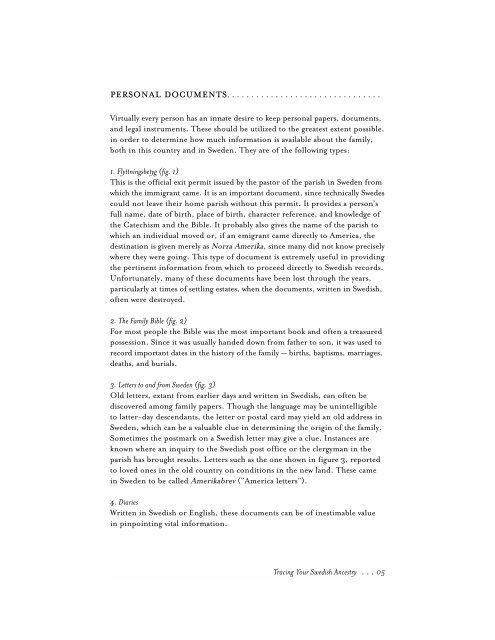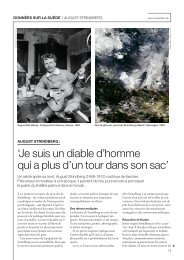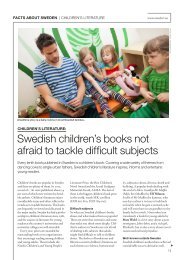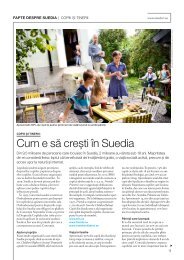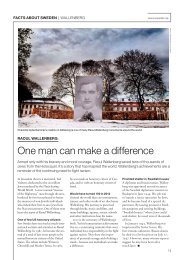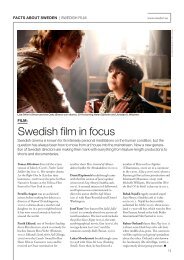Tracing your Swedish ancestry (pdf) - Sweden.se
Tracing your Swedish ancestry (pdf) - Sweden.se
Tracing your Swedish ancestry (pdf) - Sweden.se
You also want an ePaper? Increase the reach of your titles
YUMPU automatically turns print PDFs into web optimized ePapers that Google loves.
personal documents................................<br />
Virtually every person has an innate desire to keep personal papers, documents,<br />
and legal instruments. The<strong>se</strong> should be utilized to the greatest extent possible,<br />
in order to determine how much information is available about the family,<br />
both in this country and in <strong>Sweden</strong>. They are of the following types:<br />
1. Flyttningsbetyg (fig. 1)<br />
This is the official exit permit issued by the pastor of the parish in <strong>Sweden</strong> from<br />
which the immigrant came. It is an important document, since technically Swedes<br />
could not leave their home parish without this permit. It provides a person’s<br />
full name, date of birth, place of birth, character reference, and knowledge of<br />
the Catechism and the Bible. It probably also gives the name of the parish to<br />
which an individual moved or, if an emigrant came directly to America, the<br />
destination is given merely as Norra Amerika, since many did not know preci<strong>se</strong>ly<br />
where they were going. This type of document is extremely u<strong>se</strong>ful in providing<br />
the pertinent information from which to proceed directly to <strong>Swedish</strong> records.<br />
Unfortunately, many of the<strong>se</strong> documents have been lost through the years,<br />
particularly at times of <strong>se</strong>ttling estates, when the documents, written in <strong>Swedish</strong>,<br />
often were destroyed.<br />
2. The Family Bible (fig. 2)<br />
For most people the Bible was the most important book and often a treasured<br />
pos<strong>se</strong>ssion. Since it was usually handed down from father to son, it was u<strong>se</strong>d to<br />
record important dates in the history of the family — births, baptisms, marriages,<br />
deaths, and burials.<br />
3. Letters to and from <strong>Sweden</strong> (fig. 3)<br />
Old letters, extant from earlier days and written in <strong>Swedish</strong>, can often be<br />
discovered among family papers. Though the language may be unintelligible<br />
to latter-day descendants, the letter or postal card may yield an old address in<br />
<strong>Sweden</strong>, which can be a valuable clue in determining the origin of the family.<br />
Sometimes the postmark on a <strong>Swedish</strong> letter may give a clue. Instances are<br />
known where an inquiry to the <strong>Swedish</strong> post office or the clergyman in the<br />
parish has brought results. Letters such as the one shown in figure 3, reported<br />
to loved ones in the old country on conditions in the new land. The<strong>se</strong> came<br />
in <strong>Sweden</strong> to be called Amerikabrev (“America letters”).<br />
4. Diaries<br />
Written in <strong>Swedish</strong> or English, the<strong>se</strong> documents can be of inestimable value<br />
in pinpointing vital information.<br />
<strong>Tracing</strong> Your <strong>Swedish</strong> Ancestry ...05


